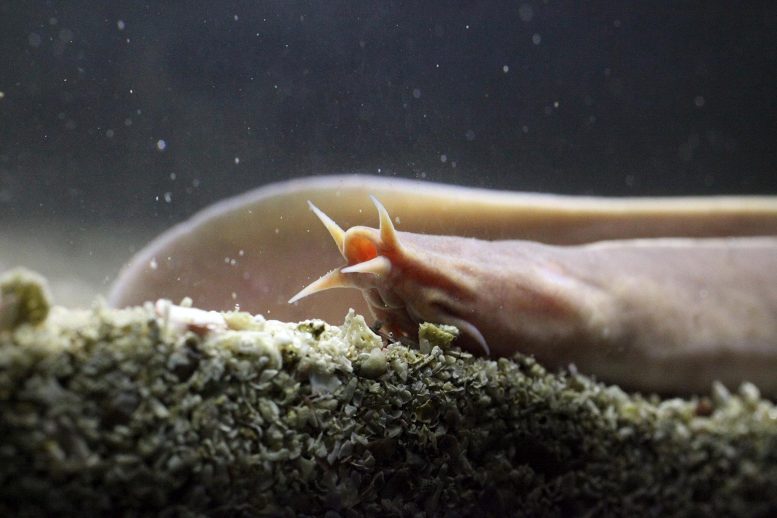
An international consortium has sequenced the hagfish genome, filling a significant gap in vertebrate evolutionary research. This work, published in Nature Ecology & Evolution, enhances understanding of genome duplications in vertebrates and their impact on the evolution of major physiological structures. Credit: Universtiy of Malaga
Researchers have sequenced the hagfish genome, providing vital insights into vertebrate evolution and genome duplication history.
An international scientific team made up of more than 40 authors from seven different countries, led by the researcher at the University of Malaga Juan Pascual Anaya, has managed to sequence the first genome of the myxini – also known as ‘hagfish’ – the only large group of vertebrates for which there was no reference genome of any of its species yet.
This finding, published today (January 12) in the scientific journal Nature Ecology & Evolution, has allowed deciphering the evolutionary history of genome duplications – number of times a genome is completely duplicated – that occurred in the ancestors of vertebrates, a group that comprises the human beings.
“This study has important implications in the evolutionary and molecular field, as it helps us understand the changes in the genome that accompanied the origin of vertebrates and their most unique structures, such as the complex brain, the jaw, and the limbs,” explains the scientist of the Department of Animal Biology of the UMA Pascual Anaya, who has coordinated the research.
Thus, this study, which has taken almost a decade, has been carried out by an international consortium that includes more than 30 institutions from Spain, United Kingdom, Japan, China, Italy, Norway, and the United States, including the University of Tokyo, the Japan research institute RIKEN, the Chinese Academy of Science and the Centre for Genomic Regulation in Barcelona, among others.
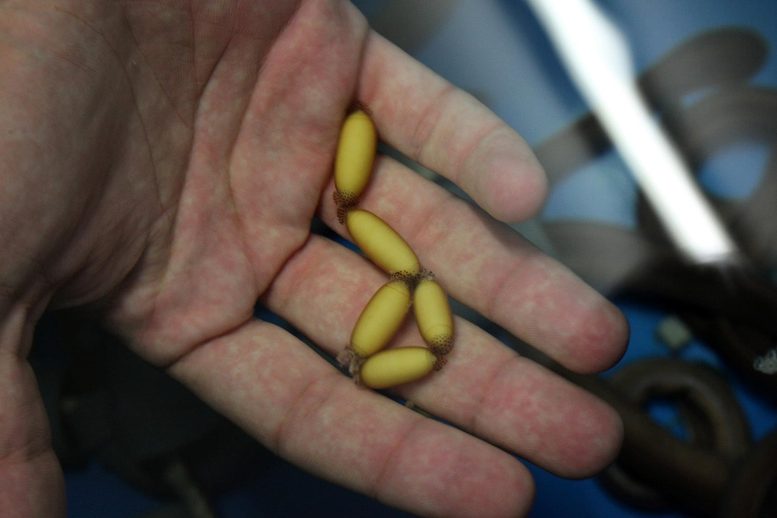
To be more specific, for this study, the genome that has been sequenced is that of the Eptatretus burgeri, which lives in the Pacific, on the coasts of East Asia. To achieve this, the researchers generated data up to 400 times the size of its genome, using advanced techniques of chromosomal proximity and managing to assemble it at the chromosome level. Credit: Universtiy of Malaga
Ecological link
The myxini or ‘hagfish’ are a group of animals that inhabit deep ocean areas. Known for the amount of mucosa they release when they feel threatened – a focus of research of cosmetic companies – and, also, for their role as an ecological link in the seabed – since they are scavengers and are responsible for eliminating, among other things, the corpses of whales that end up at the bottom of the sea after dying.
Hitherto their genome had not been sequenced due to its complexity, since they are composed of a large number of microchromosomes, which, in turn, are composed of repetitive sequences. This is in addition to the difficulty of accessing biological material.
“Besides, these microchromosomes are lost during the development of the animal, so that only the genital organs maintain a whole genome,” says Juan Pascual Anaya.
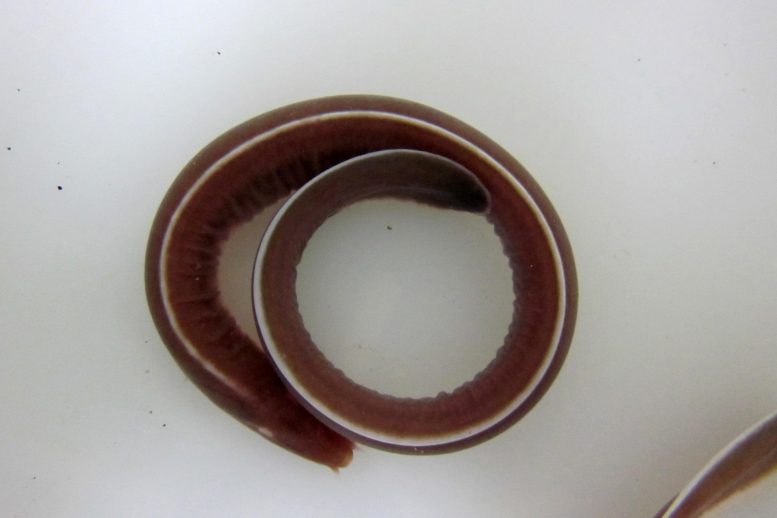
An international team led by Juan Pascual Anaya has successfully sequenced the genome of the myxini (hagfish), a critical group of vertebrates previously lacking a reference genome. Credit: Universtiy of Malaga
Genome duplications
To be more specific, for this study, in collaboration with the Chinese Academy of Science, the genome that has been sequenced is that of the Eptatretus burgeri, which lives in the Pacific, on the coasts of East Asia. To achieve this, the researchers generated data up to 400 times the size of its genome, using advanced techniques – Hi-C – of chromosomal proximity and managing to assemble it at the chromosome level.
“This is important because it allowed us to compare, for example, the order of genes between this and the rest of vertebrates, including sharks and humans, and, thus, solve one of the most important open debates in genomic evolution: the number of genome duplications, and when these occurred during the origin of the different vertebrate lineages,” says the UMA scientist, who adds that thanks to this we now know that the common ancestor of all vertebrates derived from a species which genome was completely duplicated once.
Later, according to Pascual Anaya, the lineages that gave rise to modern mandibular and non-mandibular vertebrates separated, and each of these re-multiplied its genome independently: while the former, which include humans, duplicated it, the latter tripled it.
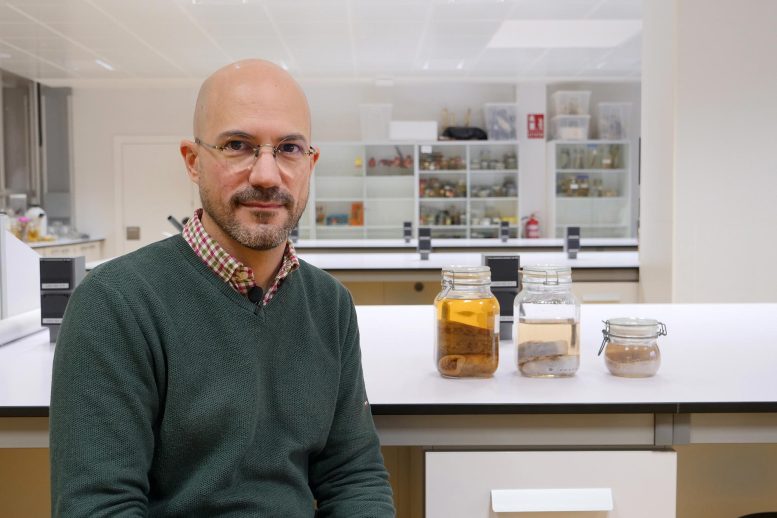
An international scientific team made up of more than 40 authors from seven different countries, led by the researcher at the University of Malaga Juan Pascual Anaya, has managed to sequence the first genome of the myxini, also known as ‘hagfish’, the only large group of vertebrates for which there was no reference genome of any of its species yet. Credit: Universtiy of Malaga
Evolutionary impact
An analysis of the functionality of genomes, based on extremely rare samples of myxini embryos, carried out in the prestigious laboratory of Professor Shigeru Kuratani of RIKEN; and a study on the possible impact of genome duplications on each vertebrate, developed together with the Professor at the University of Bristol and member of the Royal Society Phil Donoghue, complete this multidisciplinary research that is key to understanding the evolutionary history of vertebrates, since it provides perspectives on the genomic events that, probably, drove the appearance of important characteristics of vertebrates, such as brain structure, sensory organs or neural crest cells, among them, an increase in regulatory complexity, that is, a greater number of switches that turn genes on/off.
Reference: “Hagfish genome elucidates vertebrate whole-genome duplication events and their evolutionary consequences” by Daqi Yu, Yandong Ren, Masahiro Uesaka, Alan J. S. Beavan, Matthieu Muffato, Jieyu Shen, Yongxin Li, Iori Sato, Wenting Wan, James W. Clark, Joseph N. Keating, Emily M. Carlisle, Richard P. Dearden, Sam Giles, Emma Randle, Robert S. Sansom, Roberto Feuda, James F. Fleming, Fumiaki Sugahara, Carla Cummins, Mateus Patricio, Wasiu Akanni, Salvatore D’Aniello, Cristiano Bertolucci, Naoki Irie, Cantas Alev, Guojun Sheng, Alex de Mendoza, Ignacio Maeso, Manuel Irimia, Bastian Fromm, Kevin J. Peterson, Sabyasachi Das, Masayuki Hirano, Jonathan P. Rast, Max D. Cooper, Jordi Paps, Davide Pisani, Shigeru Kuratani, Fergal J. Martin, Wen Wang, Philip C. J. Donoghue, Yong E. Zhang and Juan Pascual-Anaya, 12 January 2024, Nature Ecology & Evolution.
DOI: 10.1038/s41559-023-02299-z
Juan Pascual Anaya is a scientist of the Department of Animal Biology of the University of Malaga. He studies the evolution of innovative structures that appear in different animal lineages, mainly vertebrates, for example, blood cells and the process by which they are produced, as well as other structures such as the origin of legs, hands, or jaws.
He holds a degree in Biology from the University of Malaga and a PhD in Genetics from the University of Barcelona (2010). He held a postdoctoral position for 5 years, until 2015, at the RIKEN center in Japan, in the laboratory of Professor Shigeru Kuratani, where he became independent as a Permanent Scientific Researcher until 2021, year in which he returned to the UMA as a senior researcher of the ‘Beatriz Galindo’ grant program.




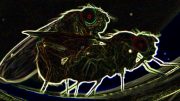


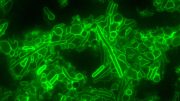

Well, you might wanna check this username @autogpt_official on telegram, I’m selling usernames to support my family, better than asking for donations I guess. 🙂 I would appreciate any help in my holy mission.
@autogpt_official